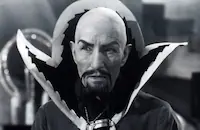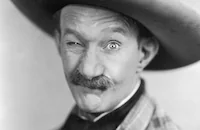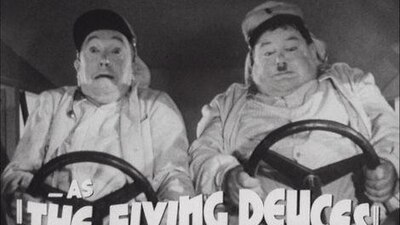The Flying Deuces

Brief Synopsis
Cast & Crew
A. Edward Sutherland
Stan Laurel
Oliver Hardy
Jean Parker
Reginald Gardiner
Charles Middleton
Film Details
Technical Specs

Synopsis
Jilted by the charming Georgette, Oliver Hardy, a fishmonger visiting Paris from Des Moines, is ready to throw himself into the Seine when a passing legionnaire advises him to join the Foreign Legion in order to forget his problems. Taking his advice, Ollie and his pal, Stan Laurel, enlist for what they believe will be a few days until Ollie overcomes his heartbreak, and the twosome find themselves enmeshed in a work routine from dawn until dusk for the pay of three cents a day. Fed up with washing and scrubbing, Stan and Ollie decide to quit the Legion, and proceed to the airport, where Ollie runs into Georgette, who, he discovers, is the wife of François, one of his superior officers. There, they are also rudely awakened to the fact that they have enlisted for life and are placed under arrest for desertion. Sentenced to be shot at sunrise, the two escape through a tunnel underneath their cell, emerging in François' compound. Amid a post-wide search, the two escape once more, leading the troops in a wild chase that culminates when Stan accidentally starts the engines of the plane in which they are hiding. The escapade results in a plane crash from which Stan emerges intact, while Ollie flutters his way to heaven, to return reincarnated as a horse.

Director
A. Edward Sutherland
Cast

Stan Laurel

Oliver Hardy

Jean Parker

Reginald Gardiner

Charles Middleton
Jean Del Val
Clem Wilenchick

James Finlayson
Crew
Howard Anderson
Nora Bayes
Frank Clarke
Jack Dennis
Elmer Dyer
Harry Langdon
John Leipold
Boris Leven
Art Lloyd
Johnny London
Rudolph Maté
Boris Morros
Boris Morros
Joe Nadel
Jack Norworth
Edward Paul
Charles Rogers
Alfred Schiller
Leo Shuken
Ralph Spence
Robert Stillman
Wm. Wilmarth

Videos
Movie Clip



Trailer
Film Details
Technical Specs

Articles
The Flying Deuces
As Richard Lewis Ward wrote in his book A History of the Hal Roach Studios, "ever since Laurel and Hardy began working at [Hal Roach Studios], as solo players and at different times, Roach had kept each under contracts as separate performers rather than as a team. Since these contracts invariably came up for renewal at different times, the situation had worked somewhat to Roach's advantage, making it difficult for the team to leave the studio as a unit to seek employment elsewhere..." Laurel had a multiple picture contract with Roach at the time, while Hardy had a multiple year contract. While Stan was on suspension he had planned to wait out the remainder of Hardy's contract with Roach, then sign with a new studio as a team.
Laurel began talking to independent film producers, and met with Boris Morros, a film composer and Broadway producer who wanted to break into movie production. Morros proposed a one-picture deal with a profit participation that Laurel found attractive. Hal Roach gave his blessing for the team to make a feature away from his studio, because a success could only make the boys more marketable for him when they returned to the fold. (When Roach earlier had a distribution deal with MGM, Laurel and Hardy made a few features and guest appearances for the prestigious studio, which helped Roach's interests immensely). Consequently, for The Flying Deuces Roach loaned out not only Hardy, but frequent Laurel & Hardy writers and gagmen Charles Rogers and Harry Langdon, and cameraman Art Lloyd. Morros also hired frequent foil James Finlayson for support, and for his director he called on comedy veteran A. Edward "Eddie" Sutherland, who had most recently directed several W. C. Fields films at Paramount.
For his story material, Morros bought the movie rights to a French farce, Les deux legionnaires, but the final film owed at least as much to a previous Laurel & Hardy film, Beau Hunks, a four-reeler from 1931 that MGM had successfully reissued in 1937. In terms of a storyline, The Flying Deuces did not attempt to break much new ground. Stan and Ollie play a couple of workers from an Iowa fish market, on vacation in France. Ollie falls in love with Georgette (Jean Parker), the innkeeper's pretty daughter, and presents her with a shimmering ring to ask her hand in marriage. Of course, she turns him down and Stan must revive Ollie with smelling salts. Ollie decides to drown himself in the Seine, and ties a rope around his waist which is attached to a concrete block. He ties the block to Stan as well, expecting his friend to join him: "After all I've done for you, you'd let me jump in there alone. Do you realize that after I'm gone, you'll just go on living by yourself? People would stare at you and wonder what you are and I wouldn't be here to tell them." Foreign Legion officer Francois (Reginald Gardiner) happens by, and advises Ollie to join the Legion to forget. Before long, Stan and Ollie are spending long hours at the post, cleaning uniforms for three cents a day. Feeling that a few days of this is plenty, they change into their civilian clothes, pack up, and try to leave the post. The post Commander (Charles Middleton) has them arrested for desertion and thrown into confinement under the watchful eye of the jailer (James Finlayson). The boys are scheduled to be shot at dawn!
Reviews at the time offered faint praise at best, but then again, critics of the day never went out of their way to praise the team. The writer for The New York Times called The Flying Deuces a "happy reunion," but said, "don't, however, expect anything new... The boys are still indulging in their same old head-bumping, pants-falling, deadpan slapstick comedy routines, with water squirting in Oliver's eyes as the most persistent device to win a howl." The writer for Variety called the film "pretty dull," and noted that there was "not much enthusiasm displayed for the comedy attempted, with exception of two brief episodes. Hardy sings chorus of 'Shine on Harvest Moon' while Laurel does some light stepping. Later, Laurel's utilization of bed springs to play a harp solo is the picture's highlight." Here the review is referring to a bizarre interlude in which the cell-bound Stan plucks out "The World Is Waiting for the Sunrise" with all the seriousness of Harpo Marx!
The Flying Deuces was a big hit with fans of the team and did quite well at the box office. While the film was still in production Roach signed Laurel to another contract for more movies. Roach had intended A Chump at Oxford (1940) to be a four-reeler and had even hoped to release it before The Flying Deuces was ready. Roach's new distributor, United Artists, demanded a feature-length film for the foreign markets and A Chump at Oxford went back before the cameras to add two more reels of footage. This allowed The Flying Deuces to win the race to the box-office.
Boris Morros went on to produce a few more films, most notably the all-star anthology Tales of Manhattan (1942). However, his greatest notoriety came upon publication of the book Ten Years a Counterspy detailing his exploits as a double Russian agent. The book was adapted into the thriller Man on a String (1960), starring Ernest Borgnine.
Producer: Boris Morros
Director: A. Edward Sutherland
Screenplay: Ralph Spence, Charley Rogers, Fred Schiller, Harry Langdon
Cinematography: Art Lloyd
Film Editing: Jack Dennis
Art Direction: Boris Leven
Music: John Leipold, Leo Shuken
Production Advisor: Rudolph Mate
Cast: Stan Laurel (Stan), Oliver Hardy (Ollie), Jean Parker (Georgette), Reginald Gardiner (Francois), Jean Del Val (Sergeant), James Finlayson (Jailer), Charles Middleton (Commandant).
BW-69m.
by John M. Miller

The Flying Deuces
Quotes
Shot at sunrise!- Oliver
I hope it's cloudy tomorrow!- Stanley
Trivia
The sketch of Stan and Ollie in the first scene was drawn by Harry Langdon.
Stan and Ollie are thrown into a cell to await execution at sunrise. Stan discovers that he can strum his bed springs and play it like a harp. The music he plays is "The World is Waiting for the Sunrise".
On the set of this film, Oliver Hardy met his future wife, script supervisor Virginia Lucille Jones.
Notes
The working title of this picture was The Aviators. According to the Variety review, this was the first comedy that Stan Laurel and Oliver Hardy made without Hal Roach. The team had previously "guest-starred" in four M-G-M films, however. After completing this picture, they returned to the Hal Roach Studios. To make this film, Boris Morros bought the rights to the 1931 French picture Les deux legionnaires, which had a similiar story. The picture marked Morros' first independent production and, according to New York Times, it was shot in continuity in four weeks with only one day needed for retakes. The 1960 film Man on a String (see below) was based on Morros' experiences. The stars, director, camermaman and art director all agreed to a minimum salary in return for a share in the profits. A news item in Hollywood Reporter adds that the film was shot on location at the Van Nuys Airport and Chatsworth, CA. Modern sources note that there are many similarities between this film and the 1931 Laurel and Hardy short entitled Beau Hunks, directed by James W. Horne. Modern sources add the following actors to the cast: Kit Guard, Billy Engle and Jack Chefe (Legionnaires); Rychard Cramer (Truck driver); Sam Lufkin and Eddie Borden (Legionnaires knocked out by corks); Frank Clarke (Pilot); Michael Visaroff (Innkeeper); and Monica Bannister, Bonnie Bannon, Mary Jane Carey and Christine Cabanne (Georgette's girl friends). Modern sources also note that during filming, Hardy met script clerk Virginia Lucille Jones, who became his third wife in 1940. For more information about Laurel and Hardy's career together, please seen entry below for Pardon Us.

Miscellaneous Notes
Released in United States 1939
Released in United States 1939














